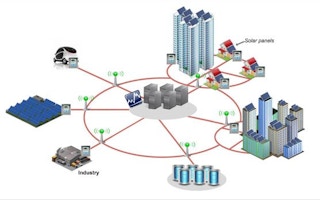Asia has done enough scattered smart grid trials, and now needs to scale up demonstrations and bring them together in large systems, said an Asia Development Bank official in Singapore on Wednesday.
ADB’s director general for regional and sustainable development Seethapathy Chander said in a surprise appearance on the first day of a National University of Singapore (NUS) symposium that Asia needed to develop smart grids to improve energy efficiency and renewable energy use.
Asia’s power grids cannot integrate enough renewable energy to meet climate change goals without smart grids, he said.
Energy efficiency and renewable energy are both local initiatives, so they improve energy security by reducing dependence on imported fuels, he added.
Mr Chander also said that the technology would help governments develop cities sustainably and improve the management of utilities.
Many governments find the idea of smart grid projects overwhelming, he admitted. His advice to them was to build on existing infrastructure and to focus on the immediate benefits of smart grids.
Such benefits include cost savings from better billing systems and less wasted energy, political goodwill from improving electricity access in remote locations, and the introduction of new renewable energy projects.
He cautioned smart grid project managers against common mistakes such as insufficient community education and the assumption that smart grid IT systems will be able to interface with other local systems without careful planning.
“The electricity network must be able to talk to transport and water networks. If not, you’re losing major value,” Mr Chander said.
Current ADB smart grid projects include developing a national and state level smart grid masterplan for India, and helping the Maldives reduce their fossil fuel dependency by installing micro-grids powered by solar energy.
ADB is also spending US$150 million over the next three years to help Uzbekistan install smart meters that will support a large scale roll-out of solar projects.
In Singapore, the government has been testing smart grid technology under its Intelligent Energy System project, which started in 2010 and will continue through 2013.
Attended by about 150 academics, government officials and industry experts, the inaugural NUS event was a two-day symposium to demonstrate the work of the university and its research and technology partners. The partners form research clusters, which combine multiple fields and industry expertise to develop practical solutions and policies for Asia.
Experts at the event noted that in addition to researching new technologies such as smart grids, the research clusters develop policy recommendations and action plans for Singapore and the region.
In a morning plenary speech, the National Environment Agency (NEA) director of environment and technology Toh Wee Khiang said that Singapore urgently needed solutions that integrated knowledge from fields as wide-ranging as business management, chemical engineering and biological carbon cycles.
He added that there was little time left to address climate change before it was locked in. “In reality the door is closing fast,” he told the audience.
With the global population predicted to hit 9 billion by 2050, the world will have to reduce energy intensity by about 9 per cent each year to avoid the worst effects of climate change, he noted.
Energy intensity is the amount of energy needed to produce each unit of gross domestic product.
In its 2009 sustainability blueprint, Singapore set a goal to achieve a 35 per cent improvement in energy efficiency from 2005 levels by 2030.
Mr Toh told Eco-Business in a separate interview that the world should aim for half of the required yearly reduction in energy intensity - 4 to 5 per cent - through improved energy efficiency, leaving renewable energy to fill the remaining gap.
Historically, the world’s governments have managed reductions of only about 1 to 2 per cent each year, with slightly higher numbers during the 1970’s energy crisis. With the possible exception of China, which started from a low base, the world has never come close to reaching the 4 to 5 per cent reductions, he said.
“Whether 4 to 5 per cent is a feasible target for Singapore needs further study, but I am using it as an initial target for a start,” he added.
Singapore’s industrial sector, which accounts for 56 per cent of the Republic’s energy consumption, holds the biggest potential for energy efficiency gains, he said.
The NEA is focusing on the four largest energy-consuming industries – petrochemical refineries, semi-conductor manufacturers, data centres and pharmaceutical plants – to find ways to reduce their emissions.
Mr Toh said that immediate solutions are not available, but that the NEA was willing to explore and fund new technologies.
Singapore has several existing funding schemes to help develop energy efficiency technologies, including research and development funding from the Economic Development Board, the NEA’s Grant for EE Technologies (GREET) programme and the National Research Foundation’s Energy National Innovation Challenge grants.
Regarding increased regulations or additional government incentives, Mr Toh said that the government was mindful of the need to maintain economic competitiveness and that policies would need to include a careful mix.
Ultimately, Singapore and the rest of the world will have to realise there are limits to growth and make hard decisions as to what is required for a sustainable environment, he noted.
“We won’t run out of energy. The atmosphere will give up long before we run out,” said Mr Toh.










